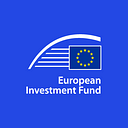What does venture capital actually do for startups?
Of course a venture capital investment is helpful for start-up businesses. But how so? What would VC-backed startups look like had they blown the investor pitch?
For the first time, we have been able to study the effects of EIF-supported venture capital on hundreds of businesses — and compare them to similar startups without that VC backing.
One clue: from that moment to five years later, VC-backed businesses leapfrog their competition.
Business size almost triples (and not just thanks to the VC investment)
VC investments make startups one to two times more capitalised than they might otherwise have been. This causes EIF-backed startups to grow about two times larger than the control group in terms of assets.
Sure, in the first two years after investment this difference can be put down to the amount of VC capital received — but the discrepancy goes on to extend beyond the investment amount itself. Why? Increased financing opportunities (follow-up investments, but also increased use of debt financing), as well as crucial non-financial added value (managerial, financial, marketing and administrative advice) brought by the EIF-backed VC investor.
Revenues are almost twice those of non-VC-backed startups…
Startups supported by EIF-backed VC investments generate revenue that is 19 % to 97 % higher than the control group — one year and five years after the initial investment, respectively.
…and employment levels are also twice as nice
Measured in terms of cost of labour, employment levels for startups backed by VC are about twice the size of non-VC-backed businesses. This is a strong indicator that VC financing supported by the EIF spurs employment growth in startups.
Anything else?
Well, EIF backing means startups can actually invest far more than non-VC backed companies in the first few years after the VC injection. Does this affect short- to medium-term profitability? Sure, it can, but
young startups are laser-focused on long-term growth and the “patient capital” of VC investors is there to help them scale up production and reach break-even.
VC backing also “signals” the quality of startups and helps them secure further debt financing. VC-backed startups borrow more, despite being relatively less collateralised than the control group. With lower levels of tangible assets, it would appear that the VC backing is an asset in itself for future debt financing.
But why is this important?
There aren’t many studies of this breadth on VC-invested startups in Europe. With the help of Invest Europe, we have been able to pull together data on more than 11,500 startups supported by venture capital between 2007 and 2014, and isolate about 800 backed by EIF early stage VC over this time period.
Previous studies hitting around 4,500 means that ours has possibly the highest coverage of the European VC landscape to date.
This study also brings in new ways and tools to study the famously opaque VC ecosystem (pro tip: never expect a VC investor to give away the secrets of their trade!). For instance, we are one of the first to use artificial intelligence to scan through start-up business models and identify promising entrepreneurial ideas. We also use geospatial data and airline routes to better simulate the way VC firms invest.
Establishing that VC-backed startups not only grow but, in fact, grow more than they would otherwise have done, is crucial in keeping this a policy priority for the European Union. Taking cornerstone investments in VC funds, as the EIF has been doing for 20 years, translates into vital support to European small businesses.
The build-up of a thriving European VC ecosystem is interlinked with the financial growth of young and innovative businesses in Europe.
Looking for the hard facts? Download the EIF’s report with venture capital association Invest EU: The Economic Impact of VC Investments Supported by the EIF.
